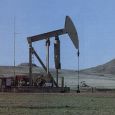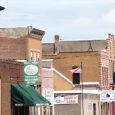The Gift of South Dakota
Subscriptions to South Dakota Magazine make great gifts!
Subscribe today — 1 year (6 issues) is just $29!
Pumping Oil Across the Plains
Mar 11, 2013
If the Keystone XL pipeline project is approved, it may take less time to build the thing than was spent arguing about it. The question stands about where it stood before last year’s election, when the President decided to put off deciding for a bit longer. That is what the State Department concluded in its second “final report.”
There are three coherent arguments against building the pipeline. The primary argument is not against the pipeline itself but against the extraction of tar sands oil in Canada. Getting the oil out of the sand releases more carbon into the atmosphere (about 5-20% more) than conventional wells. If you are concerned about carbon emissions, you will be concerned about that. A second argument is that pipes leak and the Keystone XL pipeline will bisect the US from north to south, crossing many bodies of water both above and below ground. The third is that the pipeline will require the seizure of a lot of private land.
The last item is a red herring. Environmentalists have never been shy about taking control of private property when it is damp enough to qualify as a wetland or is home to some critter of which they have become fond. As for the second, pipelines are essential to the modern economy. The US is already crisscrossed by hundreds of them and we will continue to depend on them for some time to come. The proposed route of the pipeline has been modified to carry it around the eastern edge of Nebraska’s Ogallala Aquifer.
The main argument against Keystone makes sense only if you assume that the oil will not be extracted unless the pipeline is built. Here the new report does the most damage to the opposition. As long as the oil extracted is worth a lot more than it costs to extract it, Canada will find a way to get it to the market. If it doesn’t go south it will go west to be loaded onto ships bound, across very rough seas, to China.
Keystone will bring the oil to American refineries on the Gulf coast. The thousands of jobs created in building it will be temporary, of course; however, right now we need all the jobs we can get. The jobs created to maintain the pipeline and in the refineries will not be temporary.
Likewise the value added to Canadian oil by pumping it across our fruited plains and refining it in our fruitful factories will pour money into the national bank. Some critics of the Keystone product have repeatedly claimed that not a drop of the refined oil will be used in the United States. Instead, all of it will go to China. This argument is fine if all modern economics is wrong. Oil is produced for and sold on a market. So long as there is no domestic demand for the oil then it will be sold abroad. Importing a raw material and adding value by refining it is the primary source of wealth from trade. Trade is to the international economy what the blood stream is to the body. Of course, if the pipeline is not built and the oil goes west, then you can be entirely certain that not a drop of it will contribute to our economy.
If, however, the market should change and a demand for the oil should arise here, then we will have that supply under our control. The pipeline obviously makes the US more energy independent than we would be without it.
Finally, the pipeline will cross western South Dakota. According to the State Department's Environmental Impact Statement, the pipeline project would add an additional $15.4 million to the annual property tax revenues of nine South Dakota counties. For several western counties, this will amount to a windfall.
Contrary to the dreams of the Greens, the United States is reducing both the energy and the carbon emissions necessary to produce a dollar of GDP just at the time that it is bringing online new sources of fossil fuels. The Keystone pipeline is part of this progress. There is no good reason not to build it.
Editor's Note: Ken Blanchard is our political columnist from the right. For a left-wing perspective on politics, please look for columns by Cory Heidelberger every other Wednesday on this site.
Dr. Ken Blanchard is a professor of Political Science at Northern State University and writes for the Aberdeen American News and the blog South Dakota Politics.










Comments
That same shale accounts for the systematic breakup of roadways and railbeds in South Dakota likewise confounding KeystoneXL pipeline engineers. Note this publication archived at the USGS:
".. The non-tectonic origin for this deformation is strongly supported by the observation that, since construction was completed in 1962, movement on a fault in the Pierre Shale near the spillway of Oahe Dam (about 10 km north of the city of Pierre) has created a 1.5-m-high scarp. This scarp formed without any notable seismic events."
The topic was covered at the conference of the United States Society on Dams in 2009: Slope Stability Concerns on Pierre Shale, Oahe Dam - Pierre, South Dakota...655, Robert J. Worden and Michael T. Kelly, Corps of Engineers.
There is no good reason for this assault on the Great Plains be built.
xl
http://rapidcityjournal.com/news/canadian-pacific-looks-to-sell-rail-lines-in-state/article_e01b2a20-c67c-5246-a936-8adfb42a5c7b.html
Ken--you should really check to see what the actual tax dollars are from Keystone one. Our county was shy about $900,000.00 that we were to receive. According to the EIS and TC's testimony under oath before the SDPUC.